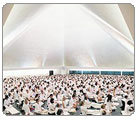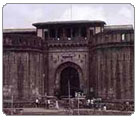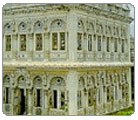|
|
Attractions in Pune City - The Offical website of the Maharashtra Tourism
Development Corporation, Govt. of India
 |
| Attraction |
|
Osho Ashram |
| Bhagwan Rajneesh's famous ashram is located at 17
Koregoan Park, a green and elite suburb of Pune. This site attracts thousands
of visitors. The Ashram offers a variety of expensive courses on meditation.
All that is required is filling out of an application form (with 2 passport
photographs) |
 |
|
and an on-the-spot HIV negative test and purchase of special
tunics.Accommodation needs to be arranged outside the ashram. Casual visitors
can view a 45 minute video presentation and take a tour (Rs. 60) at 10.00 am
and 2.30 pm daily.Please book ahead. You can easily reach this place by
auto-rickshaw. The nearby Nulla Park also called Osho Teerth, is a beautifully
maintained garden, transformed from a swamp, open for public from 6 to 9 am and
7 to 10 pm. |
|
| Shaniwar Wada |
 |
Built in 1736, Shaniwar Wada was
once the palace of the Peshwa rulers. This historic seven-storied palace was
built by Bajirao Peshwa I. During his days, it became the seat of political
power and achieved tremendous importance. To this date, Shaniwar Wada has been
the city's main landmark. Within easy reach from all parts |
|
of the city, Shaniwar Wada was mysteriously destroyed in a fire in 1827.
Mysterious fires continued to raze down portions of Shaniwar Wada in the early
19th century, and the entire palace --barring its Mirror Hall was burnt in the
fire that broke out for about a fortnight.What now remains of this once
palatial Wada are only the plinths, the fortification walls with five gateways,
and nine bastions that enclosed the whole complex, elaborate foundations of the
original palace and the nagarkhana with its fine wooden pillars and
lattice work. One enters the palace through sturdy doors designed to dissuade
enemy attacks. This palace is located in the narrow winding old part of the
city. The palace is open from 8 am to 6.30 pm. This site is covered in the Pune
city tour. |
|
| Shinde Chhatri |
Architecturally amongst
the best, just about a couple of kms from the Pune racecourse is the memorial
of the great Maratha nobleman Mahadji Shinde. You can see the warrior's painted
silver likeness, swathed in a flame-colored turban and elaborate shawl. At his
feet are the original prayer vessels, used to propitiate the family deity each
morning.
A sign asks you not to open an umbrella within the Chhatri's precincts,
as it would be an insult to the warrior's memory |
 |
|
| Raja Dinkar Kelkar Museum |
A must see, this
quaint building houses a fascinating collection of Indian artifacts collected
by the late Shree Dinkar Kelkar. The 36 sections of the museum are used to
display a wealth of antiques, carved palace doors, pottery, 17th century
miniatures, a priceless collection of nut crackers, lamps, musical items,
hookah pipes, hair drying combs and other such items from the Mughal and
Maratha period.This collection was donated to the government of Maharashtra by
Shree Dinkar Kelkar and is only displayed by rotation -- giving you another
excuse to return to Pune. The museum is open from 8.30 pm to 5.30 pm daily. The
museum is covered in the Pune city tour. |
| Pataleshwer Cave Temples |
|
Hidden in the heart of the city in the Shivajinagar area is this 8th
century rock-cut temple. Still in use, this temple, similar to the Caves at
Ellora, has been painstakingly hewn from a single rock and includes massive
pillars, a Shiva shrine and a Nandi bull. |
| Tribal Museum |
|
The Tribal Museum documents the cultures of Maharashtrian
communities, particularly those from the Sahyadri and Gondawana regions. It is
open weekdays from 10 am to 5 pm. The city tours do not halt at this site. |
| Gandhi
National Memorial / Aga Khan Palace |
The gracious
buildings with salons and suites that you see standing amidst well laid out
gardens is more that just a palace. It is a historical landmark. It was donated
to India by the Aga Khan IV in 1969. During the 1942 Quit India Movement,
Mahatma Gandhi was imprisoned here. On the grounds are the remains (samadhi)
of Kasturba Gandhi, Mahatma Gandhi's wife, who died here while in internment.
The memorial is open from 9 am to 5.45 pm. The city tour makes a stop here. |
|
Vishrambaug Wada |
This is a three-storied mansion, known for its beautiful entrance and balcony
with carved woodwork typical of the Peshwa period. The 260 ft long and 815 ft
broad Teen-Chowki Wada was built by the last Peshwa, Bajirao II as his
residence at a cost of Rs. 2 lakhs. The Wada's eye-catching wooden facade is
memorizing in its beauty, and has beautiful columns carved in the Suru form. On
October 31,1880 a surprise fire engulfed the Wada ravaging the entire
structure. Vishranbaug Wada was restored to its somewhat original appearance by
public subscriptions and municipal contributions. For many years till 1958 it
was to serve as the offices of the Poona Corporation. Today it houses assorted
offices: a strange fate for what was once a king's abode. |
|
Bund Garden |
Bund
Garden is located on the right bank of the Mula Mutha river, only a couple of
kms north-east of Pune railway station. A stroll in the breeze and a cool
evening boat ride in the back waters created by the 'Bund' on the river
attracts many fun lovers. |
| Saras Baug |
Evenings are best for a stroll
through this beautiful garden that houses the famous Ganesh Temple on the top
of a small hillock in the center. The temple was formerly surrounded by a lake,
which has been fully reclaimed in the form of an open park, now a popular
public place in Pune. |
| Parvati Hill |
This famous landmark
is located on the southern end of the city. A climb of 108 wide stone steps
rewards you with a beautiful round view of the city and an invigorating draught
of cool, fresh air. It also takes you to the group of four temples of Shiva,
Ganesh, Vishnu and Kartikeya. The Parvati Temple used to be the private shrine
of the Peshwa rulers. Also take a look at the Parvati Museum, which houses
replicas of ancient paintings, old manuscripts,
|
| Peshwe Udyan |
A zoo maintained by the Pune Municipal Corporation. It houses a variety of
species of wild animals. The zoo offers a toy-train ride -- a very special
attraction for children, and boating facilities for the family.
|
| Katraj Snake Park |
Started in 1986 with
the help of the Pune Municipal Corporation, the Katraj Snake Park is situated
on the Pune-Satara Highway near Bharati Vidyapeeth Campus. The straight road
emanating from Swargate takes you to the desired destination. The park today
has a collection of wonderful reptiles, birds, a baby leopard, crocodiles and
others. The prize collection is of course the six-year-old, nine feet long King
Cobra. |
| Pune University |
|
Pune' s oldest education institute is the Pune
University formed in 1948. The university has many affiliated education
institutes and colleges from all parts of Maharashtra -- research institutes
such as the National Chemical Laboratories, Centre for Development of Advanced
Computing (CDAC), Gokhale Institute of Politics and Economics, National
Institute of Virology (NIV) are just to name few. The IUCAA, one of the
pioneering institutes for research in astronomy, is located in the lush green
environment of Pune University, and is headed by a world renown
mathematician, Dr Jayant Naralikar.
Pune University is located on 400 acres of
sprawling grounds with quiet roads and small open canteens towards the city
limits. It was once the official residence of the Governor of Mumbai during the
monsoons, the Pune University is now a stately mansion at Ganeshkhind. A large
building in the Italian Gothic style, built with local grey tap rock, it has a
square tower 40 m high and well-maintained lawns. One can spend a pleasent
evening here. |
|
|
|
|
|